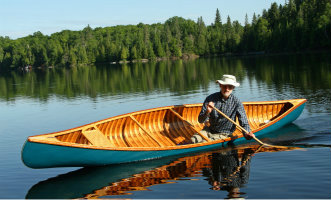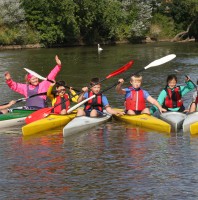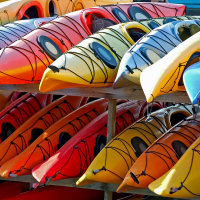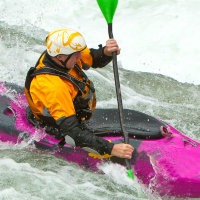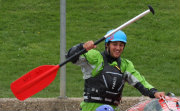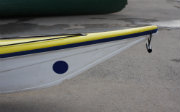Buoyancy Aids & Life Jackets for Paddlers
Buoyancy aids and /or life jackets are very strongly recommended for anyone new to canoeing or kayaking or rafting or any other paddle sport. You should expect any canoe or kayak rental store or any introductory paddling course or guided trip to provide you with a suitable PFD (personal flotation device). Those with more experience in the sport will still wear a PFD on many occasions. We will consider here the difference between buoyancy aids and life jackets, the standards you can expect to see referred to, the regulations relating to the wearing of PFDs, how to choose a comfortable appropriate PFD and when / why it might sometimes be OK to not wear your PFD.
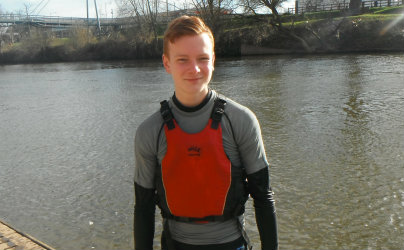
A Nicely Fitted Buoyancy Aid
The difference between Buoyancy Aids and Life Jackets (PFDs)
A buoyancy aid comprises of a material that floats e.g. PVC foam sewn into a vest. The foam is distributed fairly evenly around the body giving as much mobility as possible. A life jacket can either be made of a similar buoyant material or may look like a flat nylon or material jacket with chambers that can be filled with air or carbon dioxide when needed to create a buoyant jacket. In this instance the buoyancy is distributed more around the front and in a band behind the head. This is really important. A buoyancy aid will only help a conscious person who can swim to stay afloat. It will not stop you from drowning if you are unconscious. It will only help a weak swimmer to stay afloat but will not turn them into a strong swimmer. However a buoyancy aid is just that, it gives you more buoyancy so if you fall in you will float higher out of the water. This means that if you are in waves of any sort you will float a little higher and hopefully take in less mouthfuls of water. You will also expend less energy staying on the surface. Being made of insulating material it will keep you body warmer for longer in cold conditions. All of these properties will increase your chances of survival in an emergency situation and make life generally easier in a slightly panicked or unexpected situation. A life jacket or life vest is more likely to save you from drowning if you are unconscious or cannot swim. The idea with a life jacket is that it will turn you onto your back because the buoyancy is focused on the front and the strip of buoyancy around your neck will hold your head out of the water. There can be no guarantees but in an emergency there is a better chance that a life jacket will prevent you from drowning than a bouyancy aid will. PFD Standards
EuropeSince 1995 all PFDs on sale must have been tested in accordance with European standards and carry the CE mark which has now been replaced by an ISO standard mark. This document produced by the Scout association in the UK explains the system and different buoyancy aids / lifejackets very well. The 50N buoyancy aid is widely used in the UK for paddling activities and the Scouting document describes it as follows:
USAIn the USA PFDs may be approved by the US Coast Guard but such approval is not mandatory. Rules & Regulations on the Wearing of PFDs
UK & EuropeThere are no regulations requiring the wearing of buoyancy aids in the UK except when taking part in an event or activity where the organisers or the rules of the sport require it. This is the case in virtually all competitive paddling except for flat water sprint racing and the higher levels of some marathon racing. Other competitive disciplines require the wearing of PFDs including slalom, canoe polo, white water racing, dragon boat racing and ocean ski racing where the rules of competition set out the requirements. Many clubs will also have their own rules or guidelines. We believe that there are requirements to wear PFDs in other European countries. If you can help us out with the details we will get them put up here. USAThe US Coast Guard has a requirement that all recreational boats must carry a PFD of type I II III or V for every person on board and that boats over 16' in length must also carry a type IV throwable flotation device. The rule regarding boats over 16' in length do not apply to canoes or kayaks. Information supplied by the US Coast Guard can be found here. In addition individual states have their own regulations on the wearing of PFDs. |
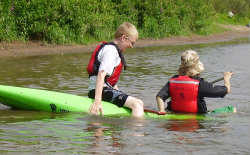 There's nothing quite like messing about in boats and a well fitting buoyancy aid enables everyone to have fun. There's nothing quite like messing about in boats and a well fitting buoyancy aid enables everyone to have fun.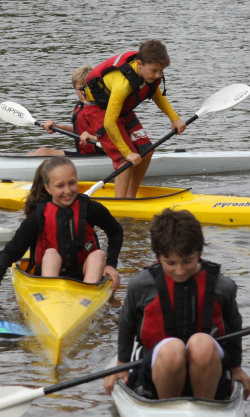 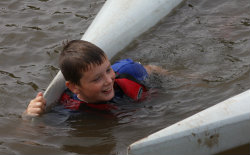 |
The difference between Buoyancy Aids and Life Jackets (PFDs)
A buoyancy aid comprises of a material that floats e.g. PVC foam sewn into a vest. The foam is distributed fairly evenly around the body giving as much mobility as possible. A life jacket can either be made of a similar buoyant material or may look like a flat nylon or material jacket with chambers that can be filled with air or carbon dioxide when needed to create a buoyant jacket. In this instance the buoyancy is distributed more around the front and in a band behind the head.
This is really important. A buoyancy aid will only help a conscious person who can swim to stay afloat. It will not stop you from drowning if you are unconscious. It will only help a weak swimmer to stay afloat but will not turn them into a strong swimmer. However a buoyancy aid is just that, it gives you more buoyancy so if you fall in you will float higher out of the water. This means that if you are in waves of any sort you will float a little higher and hopefully take in less mouthfuls of water. You will also expend less energy staying on the surface. Being made of insulating material it will keep you body warmer for longer in cold conditions. All of these properties will increase your chances of survival in an emergency situation and make life generally easier in a slightly panicked or unexpected situation.
A life jacket or life vest is more likely to save you from drowning if you are unconscious or cannot swim. The idea with a life jacket is that it will turn you onto your back because the buoyancy is focused on the front and the strip of buoyancy around your neck will hold your head out of the water. There can be no guarantees but in an emergency there is a better chance that a life jacket will prevent you from drowning than a bouyancy aid will.
PFD Standards
Europe
Since 1995 all PFDs on sale must have been tested in accordance with European standards and carry the CE mark which has now been replaced by an ISO standard mark. This document produced by the Scout association in the UK explains the system and different buoyancy aids / lifejackets very well. The 50N buoyancy aid is widely used in the UK for paddling activities and the Scouting document describes it as follows:
- "Only suitable for competent swimmers.
- Recommended for use in sheltered water where help is close at hand.
- Only provides support to conscious people who can help themselves.
- Inferior in performance to life jackets or the previous BMIF Standard for Buoyancy aids"
USA
In the USA PFDs may be approved by the US Coast Guard but such approval is not mandatory.
Rules & Regulations on the Wearing of PFDs
UK & Europe
There are no regulations requiring the wearing of buoyancy aids in the UK except when taking part in an event or activity where the organisers or the rules of the sport require it. This is the case in virtually all competitive paddling except for flat water sprint racing and the higher levels of some marathon racing. Other competitive disciplines require the wearing of PFDs including slalom, canoe polo, white water racing, dragon boat racing and ocean ski racing where the rules of competition set out the requirements. Many clubs will also have their own rules or guidelines.
We believe that there are requirements to wear PFDs in other European countries. If you can help us out with the details we will get them put up here.
USA
The US Coast Guard has a requirement that all recreational boats must carry a PFD of type I II III or V for every person on board and that boats over 16' in length must also carry a type IV throwable flotation device. The rule regarding boats over 16' in length do not apply to canoes or kayaks. Information supplied by the US Coast Guard can be found here. In addition individual states have their own regulations on the wearing of PFDs.
 Nothing quite like messing around in the water
Nothing quite like messing around in the water Make sure young paddlers have buoyancy aids the right size
Make sure young paddlers have buoyancy aids the right sizeWhat to Look for in your PFD
You want to find a PFD that is comfortable and does not restrict your paddling but that is suitable to the paddling you are doing.
Buoyancy aids come in three main styles: pull over the head, zip up the front and a few zip up the side. Zip up models can be easier to get on and off but the zip reduces the way the buoyancy can be distributed so many people prefer the pull over the head models. Look for plenty of cutaway around the arms to give freedom of movement and straps to adjust it to fit both at the sides and across the top of the shoulder. Most models come in a range of sizes. Make sure you buy one that is the right size for you.
Some models come with additional pockets to carry emergency knife, energy bars, mobile phone in waterproof bag etc. You will either want these additions or not according to what you are doing.
Slalom paddlers look for a close fit and lots of mobility as they weave around gates. Polo players will be playing under rules that require padding in the sides of the buoyancy under the arms to protect ribs from impact, white water paddlers will look for plenty of buoyancy and a secure fit to make sure it stays put in fast moving water, whilst extreme distance paddlers want something light and easy to wear but also to be sure there are no areas that will chaffe after hours on the water.
You will find cheaper models. Do not be put off these providing they meet required standards and have the necessary adjustments. However be aware that the material used may be lighter and the foam may not be cut in one piece. Water between the pieces of foam does not dry out as well so these may go mouldy more quickly than more expensive models especially if they are not kept somewhere dry and airy. If you don't paddle that much they will be fine but for frequent use and or use by clubs etc. they will not have the same life as the slightly more expensive models.
If you feel that a life jacket is what you need (well worth it for young children) look for a good fit with good buckles to adjust it to fit. If it isn't fitted well it won't do its job.
Children's buoyancy aids often come with leg straps that hold the jacket down and stop if floating up over the head. We've never found these very popular with kids as they can be uncomfortable and fiddly to set up. We would recommend getting any child who is afloat to swim in their PFD somewhere safe before using it in anger. Check how well it stays on them and adjust it to fit well. You need to know that if they fall in they are confident swimming in the kit they will be wearing at the time.
When Should you Wear a PFD?
 Everyone can enjoy the water with a PFD and some suitable supervision
Everyone can enjoy the water with a PFD and some suitable supervisionThere are some fairly hard and fast principals adhered to by most paddlers. These are that beginners and those paddling on the sea or white water always wear buoyancy aids. It is mainly in the area of flat water racing sprint and marathon that buoyancy aids are not the norm for experienced paddlers in good weather and on calm water. Common sense and respect for the elements (along with experience and training in risk assessment) is what you need in deciding whether not wearing a buoyancy aid is appropriate. A good rule of thumb is always "If in doubt, if I'm even asking the question... put one on".
By way of example I have absolutely no qualms at all about paddling up our local river on a warm summers day in my racing boat (which is not that stable) on my own. The reason is that I know the chances of me falling in are very low (I don't think I have ever fallen in when on my own as there are no distractions) and if i do fall in I've rescued lots of people from the river over many years, I know where to go, what to do, I know I can swim my boat somewhere safe and I know I won't get too cold doing so.
However ask me to paddle the same stretch of river in mid winter in a more stable boat with a group of friends to rescue me and I will be wearing a buoyancy aid because I know that if i go in (which does happen about once a year paddling in a big group with some jockeying for position, paddle clashes etc!) and they don't pull me out quickly I'm going to be at risk of hypothermia, my energy levels will reduce rapidly and I will be glad of the buoyancy aid's help keeping me afloat and keeping my core warm.
We've tried to explain the basis of risk assessing the need for a buoyancy aid in the box below. The more factors that make it more likely you might fall in and the more factors that make the consequences of falling in severe the more important it is to be wearing a PFD. We recommend paddling with a PFD unless you have enough experience and some training in risk assessment to know you are making the right decision. If you are considering paddling without a buoyancy aid please think it through very carefully.
Need for PDF Increases down the list
Stable Boat, Experienced Paddler, Calm Conditions, Familiar Location, Warm Weather, Close to Shore, Paddling with others
Mid stability boat, Intermediate level paddler, Potential for some rough water, Been to the venue once before, autumn temperatures, two paddlers
Unstable Boat, Inexperienced Paddler, Rough Water, Unfamiliar Location, Cold Weather, Off shore, Paddling alone
|
Likelihood of Falling In |
|
Consequences of Falling in |
Low - Stable boat, experienced paddler, known water, easy water |
Medium |
High - Unstable boat, inexperienced paddler, unknown water, rough conditions |
|
Low warm weather, close to shore, good swimmer, others around. |
PFD least necessary |
A good swimmer might choose not to wear a PFD on a hot summers day whilst trying out an unstable boat in shallow water with others around to assist. | |
|
Medium |
A confident experienced racing paddler in an unstable boat which they are very competent in will probably weigh up the risks each time they paddle according to temperature and water conditions. | ||
|
Severe cold weather, long trip away from base, paddling alone, weak swimmer |
Even experienced paddlers paddling on water they are very familiar with in stable boats would be wise to wear a PFD in very cold weather when the water is cold. |
PFD very necessary |
- Home
- Accessories
- Buoyancy Aids
